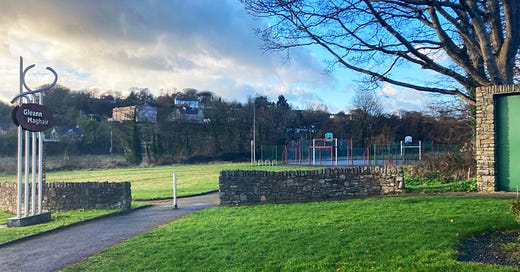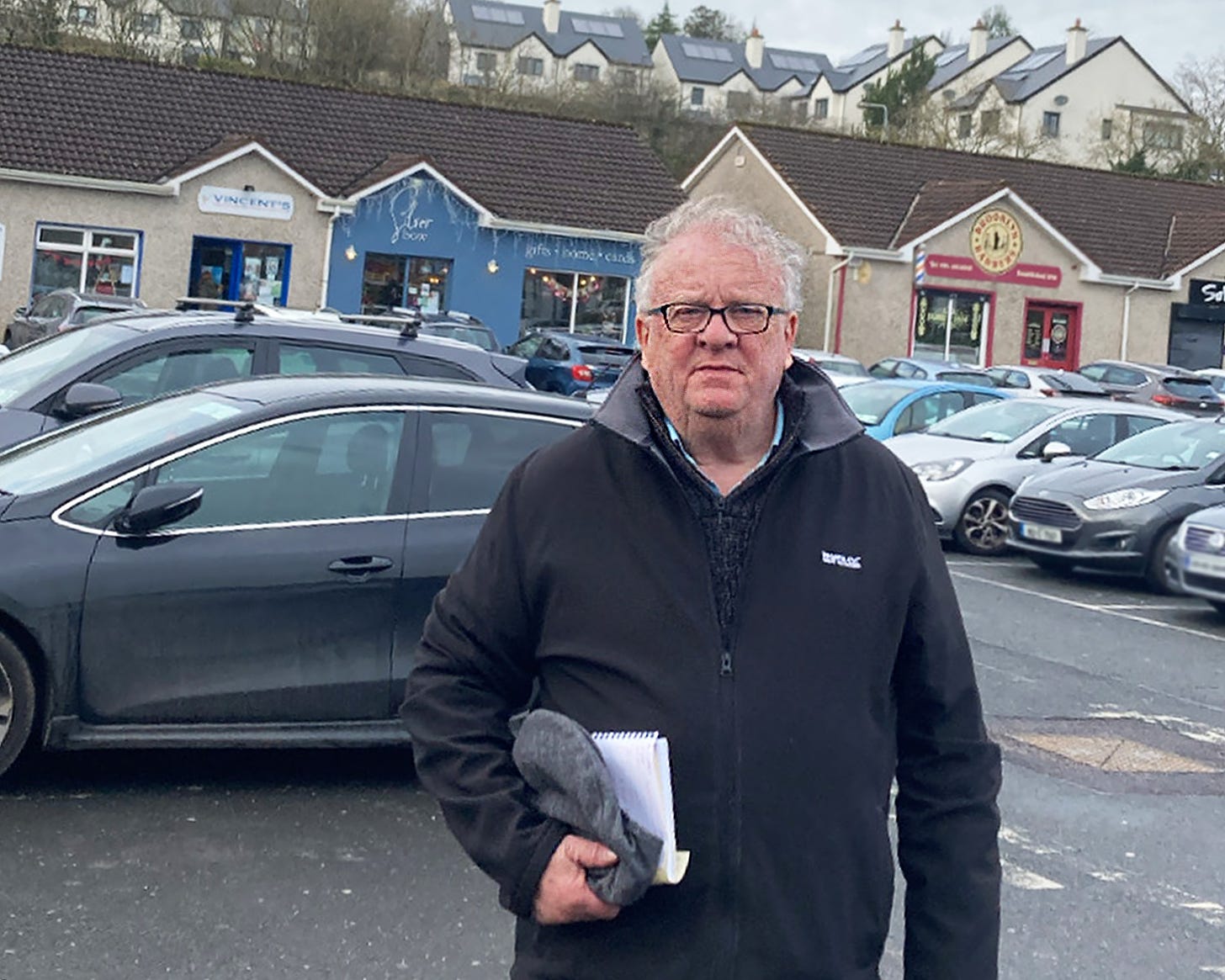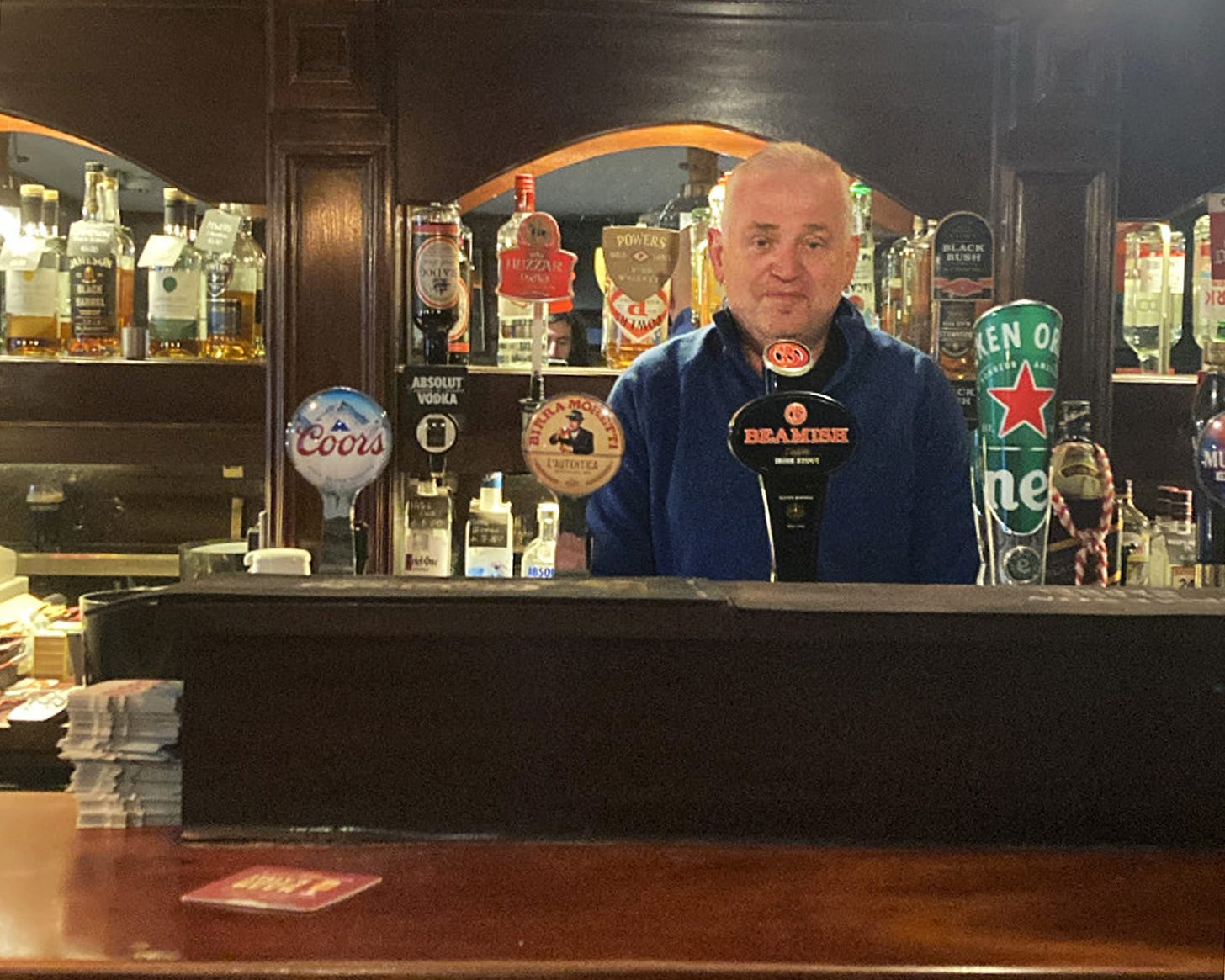Space to play: what's next for Glanmire?
As Glanmire's population explodes, there's an increasing focus on its outdoor spaces, but is a Regional Park through its core an amenity that's wanted and needed?
You could call Glanmire a town, but it doesn’t have a town centre. You could call it a suburb, but it isn’t contiguous to the city.
Perhaps the most apt description of Glanmire is as an area comprised of four separate villages, delineated by the M8 to the east and the Barnavara Hill to the west.
Glanmire village sits atop the estuary, the former focal point of the valley. Upriver, through some woods, is Riverstown, comprising of a busy main street, the main supermarkets, Sarsfields GAA, and the Hazelwood shopping centre.
Nearby is the village of Brooklodge, with a garage and schools, while to the north is Sallybrook, with the church, a pub, Glanmire GAA, and a garage.
Included in the city since the 2019 boundary extension, the conurbation of villages is undergoing a rapid population expansion under the Cork City Development Plan 2022-2028. The Ballinglanna and Dunkettle housing estates alone will eventually add 1,400 new houses to the area.
But it’s a process that really began 30 years ago. The early ‘90s saw the construction of Hazelwood, one of the first developments built by the late Owen O’Callaghan, which brought new families to the area, including my own, and changed the dynamic of the area.
“We’ve seen massive changes, from an area that was 1,500 people to an area that has grown to basically 20,000 people,” publican Tim O’Callaghan, owner of The Widows Bar in Glanmire village, tells me.
“Glanmire and Riverstown would have been connected, we’d say 20-30 years ago, because Glanmire had the post office, which was a massive draw. You had Barry’s shop, which was the supermarket in the area, and you had the garage where Grandon’s is now, which was another one of the Barrys. But they also had an undertaking business, so the focus was down this side.”
“The council kind of changed it then and they put in the Hazelwood and Crestfield centre, so the demographics changed.”
The John Barleycorn hotel, in Riverstown, was once another draw to the area before its growth, and an old landmark, despite its situation on land prone to flooding by the Glashaboy River.
The day of the blaze
“The John Barleycorn was the hotel back in the ‘70s, and there were weddings there every single day from Wednesday to Saturday,” Tim says.
“It would be fully booked up and a beautiful setting, lovely old-style, boutique-type of hotel, and basically then there was some developer and he had major plans with it but then the Celtic Tiger collapsed and it’s sitting there since. I remember the fire, and they have to be very careful there with the flood plains.”
I also remember the fire. On a quiet Sunday in August 2006, a 10-year-old me was playing soccer with my brother in our back garden. Thick smoke started bellowing over the area, coming from Riverstown.
I convinced my dad to take me down for a look, where a crowd had gathered outside Billy Meaney’s shop, as the blaze engulfing the 18th century former coach stop provided the town’s morbid afternoon entertainment.
The then-owner of the John Barleycorn, John Donovan, had recently purchased the hotel and wanted to demolish the building and develop a discount store and apartments.
Three children, one eight, one nine and one twelve years old, were questioned about the fire, and were lucky to have escaped from the building with their lives.
Billy Meaney’s shop closed down not long after the fire and was eventually demolished. It is now the site of a bottle bank and the car park for a Lidl supermarket: another piece of evidence of the old Glanmire lost and another piece of evidence of the transition from an old rural area to a modern city suburb.
A satellite town
In 2008, two years after the John Barleycorn fire, local hurling club Sarsfields won their first county championship since 1957, and club captain Kieran ‘Fraggie’ Murphy’s speech addressed the changes seen in the area. “Last time we won, Glanmire was a village,” he announced to the crowd, “now, it’s a satellite town!”
The John Barleycorn site remains idle, however, opposite the current John O’Callaghan Park and amongst the thick woodland valley which separates Glanmire and Riverstown.
The site is worth €1.5 million and zoned for town centre use, but local councillor Ger Keohane has called on the council to purchase it to create a new regional park for Glanmire. More recently involved is Glyntown House, on a site spanning 21 acres which stretches from the John O’Callaghan Park to Glanmire village, which local TD Pádraig O’Sullivan has called on the council to also purchase.
That site includes lands leased to the local soccer club, Riverstown FC, and would connect Glanmire and Riverstown villages and allow people to walk between the two without taking the busy main road.
The site also borders the new Ballinglanna development and could seamlessly link it with already established neighbourhoods across the valley. A regional park would put an open green area at the heart of the settlement and could span up to 40 acres.
This potential park is one of numerous campaigns by local residents to bring new amenities to the area. Local campaigner Ger Moloney runs the Glanmire Noticeboard social media pages and the Mums of Glanmire Facebook group. She is also the chair of a committee to create a new playground, in a space known as the MUGA (Multi-use games area), near Hazelwood.

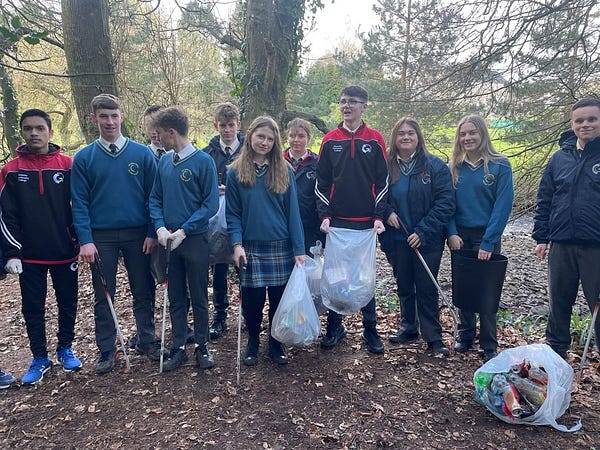
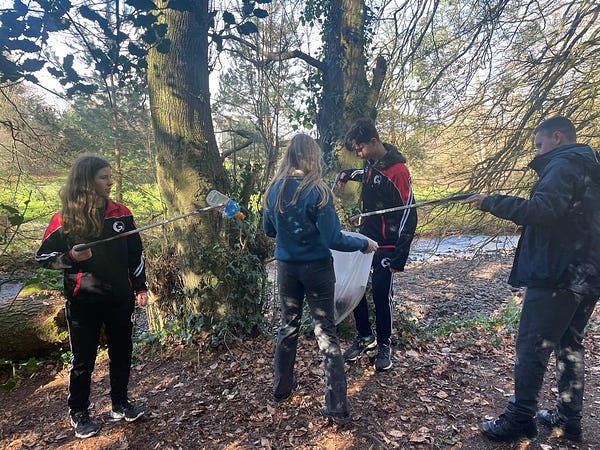
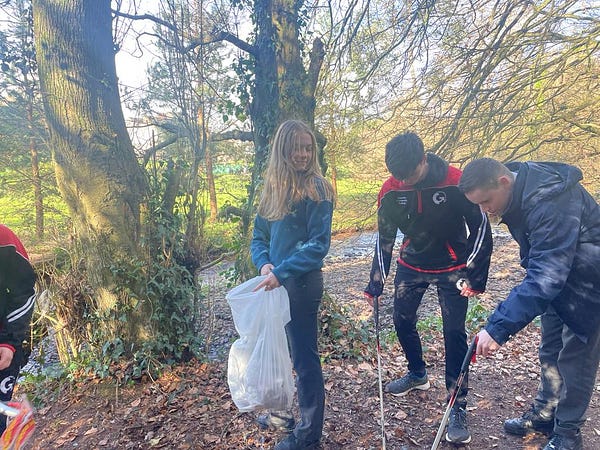
“We set up a committee about two years ago to try and get a decent playground over at the MUGA, where we actually put in plans to the city council,” she says.
The committee’s plans include “an amenity area for a little park, a playground at the front, and behind a board area, with lumps and bumps. So at the moment, we’re waiting for the city council to come back to us with an answer.”
The committee was borne out of frustration at a perceived lack of resources for a growing area: Ger believes that Glanmire hasn’t been as well looked after as other areas of the county, something which will become more evident as the area grows.
“We have three new estates gone in here in the last two years, and they’re all starting to be developed”, she says. “That’s a huge growth of population coming into an area already full of houses. I mean, when you look at other areas like Ballincollig or Carrigaline, look how developed they are, look at the parks in Ballincollig for the area that it is. Glanmire really falls behind in amenities for young people in the area.”
However, not everybody in the area agrees with Ger that new amenities are necessary.
Michael Burns is the director of the Glanmire Area Community Association (GACA), has worked with the association for 30 years, since he was instrumental in the creation of the playground at John O’Callaghan Park 30 years ago.
He says he’s been unaware of any campaigns for other local amenities.
In Michael’s view, the current playground, along with local sports clubs, are enough resources for the area: he’s more concerned at the lack of involvement in the amenities that are on offer.
“The hurling club, the football club, the soccer club, the rugby club: at the moment we’re looking for people to be involved in these things”, he says. “People are apathetic in Glanmire. When it comes to getting things done, I want the parents to get involved. They don’t!”
Such is the lack of involvement, he says, that he doesn’t believe the demand is there for any more substantial facilities. “We had two swimming pools, all closed down, tennis courts all closed down, from lack of use,” he says.
“What are they doing, why aren’t they at the clubs? Once upon a time in the MUGA they’d be playing soccer, seven-a-side, we organised it ourselves. There were all the soccer matches on in the park, why aren’t the youngfellas doing that, why aren’t they playing seven-a-side?”
Flood risk
He also describes any community or council efforts to take over the John Barleycorn site as “pie in the sky,” given existing flood risks in the area: “sort out the flooding and we can talk about it then.”
But other people within GACA are working towards the creation of new amenities in the area: Lorraine O’Neill is one, and has worked closely with the city council to bring investment to the area.
“We applied for the Town and Village Renewal Scheme,” Lorraine says. “When we were applying, we linked up quite closely with Cork City Council and they said the best thing to apply for was to put money into the existing park, the John O’Callaghan Park.”
Glanmire has had problems with antisocial behaviour in the past, although it has quietened down in the past few years. The park is, however, unprotected from any potential resurgence.
Peter, Josh and Harry
Teenagers often hang out outside Supervalu. I ask three, Peter, Josh and Harry, what they do around the area. “Play soccer in the soccer court, go up to the gym, every once in a while, maybe three times a week,” Peter says. They say they are usually quite bored.
However, they don’t want much more than what’s currently available. When I ask what they’d like to see in the town, Harry says a cinema would be nice. “We just want somewhere to go,” Peter says. “We’re just hanging out here. There’s not much places to go around.”
Lorraine O’Neill recognises this as an issue, and wants to create a local hub with community facilities.
“If say, down the line, they developed a new hub, a centre for Glanmire, I think that maybe they should incorporate something within that for teenagers,” she says. “Maybe there could be a supervised hang-out area that they can go in and get cheaper cans of coke.”
But she knows that teenagers can be choosy, that what is deemed a cool place to hang out can change at a moments’ notice: the answer here, she feels, is engaging young people and giving them a sense of ownership.
A Glanmire “health check”
“Another thing that they suggested is that they’d put some of the funding towards what they call a health check for Glanmire”, she says. “They’ll do independent surveys and an overall review of all of Glanmire, and that’s going to be huge for us going forward, because they’ll come back with what they recommend is good for our area. I think that’s very important, because with the health check they look at what’s viable.”
The health check would offer step by step improvements and a long-term vision for the area. “So it’s baby steps”, Lorraine says. “The park is the first step, the next step I think which should happen is to fight for the Barleycorn land.”
As an undeveloped space at the heart of the area, the John Barleycorn landbank is a major determinant in the future of the area. Lorraine believes it should be included in any expansion of the park.
“I think that Glanmire would benefit from all that John Barleycorn area as a green area for Glanmire,” she says. “It’s so central and even if it’s a flood plain, they’re rectifying that with the flood relief scheme, so I think a huge park and walkway and greenway there would be the way to go.”
Back at The Widows, Tim O’Callaghan is upbeat about the offerings for young people in the area. Other voluntary work to occupy teenagers is happening, and Tim knows locals who are working towards creating spaces for teenagers. He mentions Dave O’Connell, who runs the Glanmire House of Rock.
“I think there’s some great organisations being set up,” he says. “I see young lads being looked after and all for nothing; these people are doing it for no material gain.”
Tim believes that there have been major improvements to the overall area, and recently, to Glanmire village. “The bus service has improved massively to every twenty minutes and that is a good thing,” he says.
He lauds the recently completed road improvement works in the upper half of the village: “If they could do the lower half now of the village, from Church Hill right up through the village it would really improve the place, plus the bus stops and everything, top class.”
However, there are issues with parking in Glanmire village and Tim says this has affected business. “If you came into the village long ago, you had four pubs here, I’m the only one left now,” he tells me, “Barry’s shop is gone, the Post Office is gone, Lynch’s off licence is gone. Things have changed; now the big thing in Glanmire is parking. Parking has become a major, major issue. There’s actually no parking, not to mention for people who want to come here, but for people who live here as well.”
He says locals are hoping parking spaces will become available at the back of the AIB. “If the city council bought the car park and put parking in there it would be a massive revitalisation for the village.”
There are also plans to improve the streetscape in the village, on top of the recently completed road improvement works, which includes parking.
So far, the only commitments made have been to improve the playground, and to improve the streetscape and parking situation in Glanmire village.
Tim O’Callaghan recognises that each area of Glanmire does its own thing, and that that might not be a bad thing. “It’s good for each area to have their own identities,” he says, “Sallybrook focus on doing the tidy towns which looks brilliant. And the area around the Castle Tavern, that looks brilliant, and down here there’s great people doing trojan work making the village look better. I think the areas in good shape.”
These volunteers have already done so much campaigning and so much work, but nothing is confirmed. At this stage, it’s a waiting game on the council to build on their huge efforts.

